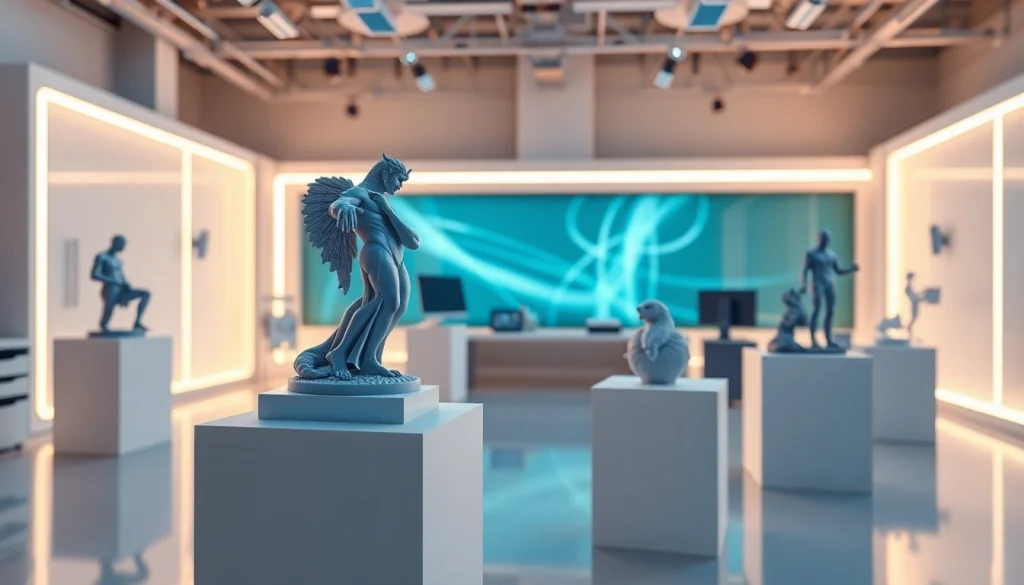
Understanding 3D Model Visualizations
In today’s digital age, the ability to visualize concepts and designs in three dimensions has become essential across various industries. 3D Model Visualizations offer a powerful means of communicating intricate ideas and fostering understanding among stakeholders. By leveraging advanced technologies, designers can create realistic representations of their work, which not only captivates audiences but also enhances collaboration and decision-making processes.
Definition and Importance
3D model visualization refers to the process of creating graphical content in three dimensions, enabling viewers to explore and interact with digital objects. Unlike traditional 2D images, 3D visualizations allow for depth perception, providing a more comprehensive understanding of dimensions, shapes, and spatial relationships. The significance of this technology cannot be overstated, particularly in fields like architecture, engineering, and product design, where a clear depiction of an idea can make all the difference in gaining client approval or attracting investors.
Key Benefits for Designers
For designers, 3D visualizations offer numerous advantages:
- Improved Communication: 3D models enable a more intuitive discussion of design features and functionalities, ensuring that all stakeholders are on the same page.
- Reduced Errors: Visualizing a product in 3D allows designers to identify and address potential issues early in the project timeline, reducing the risk of costly mistakes.
- Enhancements in Marketing: High-quality visualizations serve as compelling marketing tools, providing potential customers with a clearer understanding of a product’s benefits and aesthetics.
- Facilitation of Collaboration: Teams can easily share and review 3D models, prompting constructive feedback and collaborative refinement of designs.
Common Applications in Various Industries
3D model visualizations find application across numerous sectors:
- Architecture: Architects utilize 3D visualizations to present building designs to clients, showcasing everything from exterior facades to interior layouts.
- Product Design: Designers create prototypes of new products, enabling stakeholders to interact with a digital version before physical production.
- Gaming: In game development, 3D artists produce immersive environments and characters, enhancing player experiences through rich graphics.
- Medical: 3D imaging aids in the development of medical devices and surgical planning, offering insights that improve patient outcomes.
Essential Tools for 3D Model Visualizations
Top Software Options Available
Several software solutions are available for creating 3D model visualizations, each catering to different needs and skill levels:
- Autodesk Maya: A powerful 3D modeling, animation, and rendering software widely utilized in the film and gaming industries.
- Blender: An open-source 3D modeling tool that offers robust functionalities for modeling, animation, and rendering.
- SketchUp: Known for its user-friendly interface, SketchUp is ideal for architects and interior designers who require quick yet effective modeling capabilities.
- 3ds Max: Popular among game developers and visual effects artists, 3ds Max offers extensive features for complex modeling and rendering.
- Unity: Primarily a game development engine, Unity also serves as a platform for interactive 3D visualizations and simulations.
Online Platforms vs. Desktop Applications
The choice between online platforms and desktop applications depends largely on user needs and the scope of the project. Online platforms such as Sketchfab provide accessibility for quick sharing and collaboration, making them ideal for teams that need to present ideas remotely. Conversely, desktop applications generally offer more extensive tools and capabilities, suitable for detailed and complex modeling tasks.
Criteria for Selecting the Right Tool
When selecting a software solution for 3D modeling visualizations, consider the following factors:
- Purpose: Define the primary goals – whether creating models for presentation, prototyping, or animation will guide the software choice.
- Budget: Free and open-source options may be appropriate for those starting, while larger projects may require investment in premium software.
- Learning Curve: Assess the amount of time you can devote to learning – complex programs may take longer to master than simpler alternatives.
- Compatibility: Ensure that the chosen software integrates well with other tools and file formats that may be in use in your workflow.
Techniques for Creating Stunning 3D Model Visualizations
Best Practices for 3D Modeling
Achieving high-quality results in 3D modeling involves adhering to a set of best practices:
- Start with a Strong Concept: A clear vision of the final product helps streamline the modeling process and ensures accuracy in dimensions and shapes.
- Utilize Reference Materials: Use blueprints, sketches, or reference images to guide the modeling process and keep proportions accurate.
- Optimize Geometry: Strive for a balance between detail and performance; avoid excessive polygons that may hinder software performance.
- Work with Layers: Organizing models into layers facilitates easier editing and enhances workflow efficiency.
Lighting and Texturing Techniques
Incorporating dynamic lighting and textures elevates 3D visualizations, providing realism and depth:
- Lighting: Experiment with different light sources, angles, and shadows to create a suitable atmosphere for the scene. Consider natural lighting for outdoor scenes and artificial lighting for indoor environments.
- Texturing: Apply high-quality textures to surfaces to enhance realism. Use texture mapping techniques to give depth and character to objects.
- Environment: Setting up a background or environment not only provides context but also acts as a stage for the 3D model, driving engagement.
Rendering Tips for High-Quality Outputs
The rendering stage transforms the model into the final visual product. To ensure the best output:
- Choose Appropriate Settings: Adjust resolution and quality settings based on the intended use; high-resolution outputs are vital for prints, while lower resolutions suffice for online use.
- Test Renders: Conduct multiple test renders to analyze how the model appears under various lighting and texture conditions before finalizing.
- Utilize Ray Tracing: Employ ray tracing techniques to produce realistic light behavior and reflections in your 3D scenes.
Case Studies: Successful 3D Model Visualizations in Action
Architectural Visualization Success Stories
Architectural firms frequently leverage 3D visualizations in their design processes. One prominent example is the use of 3D models to showcase potential commercial buildings to clients. These visualizations enable clients to experience virtual walkthroughs, assess designs accurately, and make informed decisions regarding their projects.
Product Design Showcases
In product design, companies like Apple have relied on 3D visualization to prototype new devices. By creating 3D models of each prototype iteration, designers can gather feedback and incorporate changes rapidly, ensuring that the final product meets market expectations.
Artistic and Educational Examples
3D visualizations also play a significant role in the arts and education sectors. For instance, museums utilize 3D modeling to recreate historical artifacts and sites, allowing remote viewers from around the world to engage with these resources through interactive visualizations.
Future Trends in 3D Model Visualizations
Emerging Technologies in Visualization
The future of 3D model visualization is heavily reliant on advancements in technology. Innovations such as AI-driven modeling tools and advanced rendering techniques are paving the way for even more impressive designs and faster processing times. As these technologies evolve, designers will find greater ease in creating ultra-realistic models.
Integration with Virtual and Augmented Reality
Virtual reality (VR) and augmented reality (AR) are increasingly integrated into 3D modeling workflows. These technologies enable users to experience models in immersive environments, transforming interactions with designs. For architects, this means clients can walk through a virtual building before it is constructed, enhancing the approval process and mitigating potential design flaws.
Building Skills for the Future of Design
As the demand for high-quality 3D visualizations continues to grow, so does the necessity for designers to constantly refine their skills. Online courses, workshops, and training sessions focusing on the latest tools and techniques will become essential in staying competitive in this evolving landscape.






